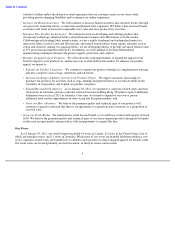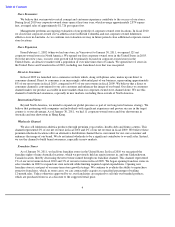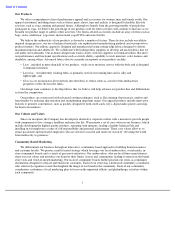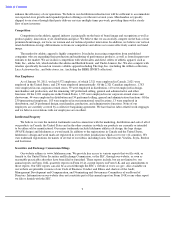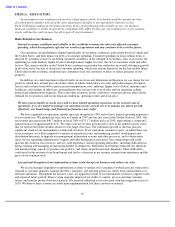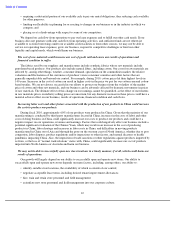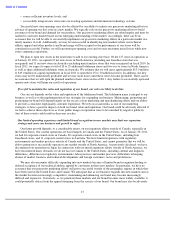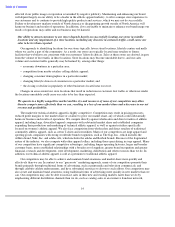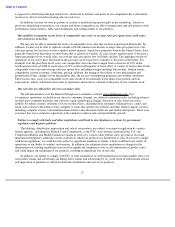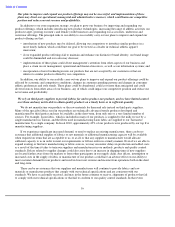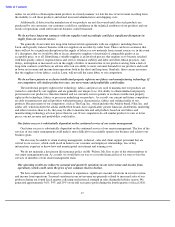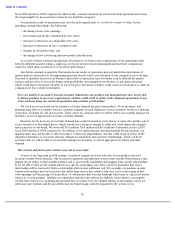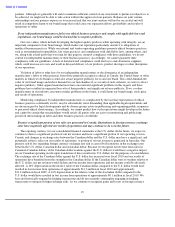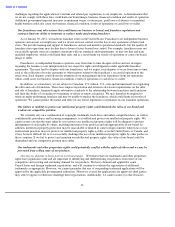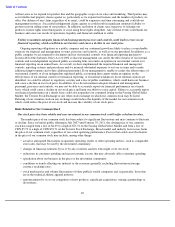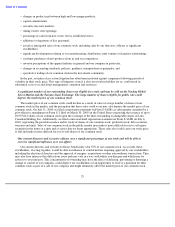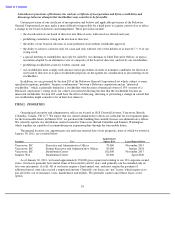Lululemon 2010 Annual Report Download - page 19
Download and view the complete annual report
Please find page 19 of the 2010 Lululemon annual report below. You can navigate through the pages in the report by either clicking on the pages listed below, or by using the keyword search tool below to find specific information within the annual report.
Table of Contents
affected if our public image or reputation is tarnished by negative publicity. Maintaining and enhancing our brand
will depend largely on our ability to be a leader in the athletic apparel industry, to offer a unique store experience to
our customers and to continue to provide high quality products and services, which we may not do successfully.
Failure to develop new markets outside of North America or disappointing growth outside of North America will
harm our business and results of operations. In addition, if we are unable to maintain or enhance our brand image our
results of operations may suffer and our business may be harmed.
Our ability to attract customers to our stores depends heavily on successfully locating our stores in suitable
locations and any impairment of a store location, including any decrease in customer traffic, could cause our
sales to be less than expected.
Our approach to identifying locations for our stores typically favors street locations, lifestyle centers and malls
where we can be a part of the community. As a result, our stores are typically located near retailers or fitness
facilities that we believe are consistent with our customers’
lifestyle choices. Sales at these stores are derived, in part,
from the volume of foot traffic in these locations. Store locations may become unsuitable due to, and our sales
volume and customer traffic generally may be harmed by, among other things:
Changes in areas around our store locations that result in reductions in customer foot traffic or otherwise render
the locations unsuitable could cause our sales to be less than expected.
We operate in a highly competitive market and the size and resources of some of our competitors may allow
them to compete more effectively than we can, resulting in a loss of our market share and a decrease in our net
revenue and profitability.
The market for technical athletic apparel is highly competitive. Competition may result in pricing pressures,
reduced profit margins or lost market share or a failure to grow our market share, any of which could substantially
harm our business and results of operations. We compete directly against wholesalers and direct retailers of athletic
apparel, including large, diversified apparel companies with substantial market share and established companies
expanding their production and marketing of technical athletic apparel, as well as against retailers specifically
focused on women’s athletic apparel. We also face competition from wholesalers and direct retailers of traditional
commodity athletic apparel, such as cotton T-shirts and sweatshirts. Many of our competitors are large apparel and
sporting goods companies with strong worldwide brand recognition, such as The Gap, Inc., which includes the
Athleta brand, Nike, Inc. and adidas AG, which includes the adidas and Reebok brands. Because of the fragmented
nature of the industry, we also compete with other apparel sellers, including those specializing in yoga apparel. Many
of our competitors have significant competitive advantages, including longer operating histories, larger and broader
customer bases, more established relationships with a broader set of suppliers, greater brand recognition and greater
financial, research and development, store development, marketing, distribution and other resources than we do. In
addition, our technical athletic apparel is sold at a premium to traditional athletic apparel.
Our competitors may be able to achieve and maintain brand awareness and market share more quickly and
effectively than we can. In contrast to our “grassroots” marketing approach, many of our competitors promote their
brands primarily through traditional forms of advertising, such as print media and television commercials, and
through celebrity athlete endorsements, and have substantial resources to devote to such efforts. Our competitors may
also create and maintain brand awareness using traditional forms of advertising more quickly in new markets than we
can. Our competitors may also be able to increase sales in their new and existing markets faster than we do by
emphasizing different distribution channels than we do, such as catalog sales or an extensive franchise network,
14
•
economic downturns in a particular area;
•
competition from nearby retailers selling athletic apparel;
•
changing consumer demographics in a particular market;
•
changing lifestyle choices of consumers in a particular market; and
•
the closing or decline in popularity of other businesses located near our store.


